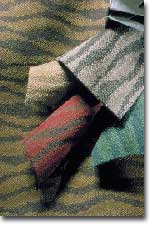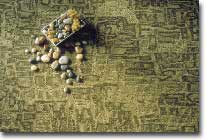The first three respondents to the Yarn Market this month set an optimistic tone which hasn’t been
heard from cotton spinners in months. “A11 markets are busy. We are running full – seven days.”
This from an open-end spinner.
3 The second spinner commented: “Our markets are great for both open-end and ring-spun
yarns. We are on a full seven-day schedule and can’t meet the demand.”
The third yarn man, speaking of his markets, said: “They are tight across the board.
Ring-spun carded-cotton yarns are especially tight, but ring-spun combed is almost as strong.”
All three mentioned that their customers were optimistic as well. So optimistic in fact that
spinners are beginning to make projections of superior markets for several months ahead. In the
recent past, most spinners would tell you that they couldn’t predict what would happen tomorrow or
next week, let alone several months ahead. Here again, all three commented that they were sold up.
When a spinner was asked what caused the upsurge in business, particularly in open-end
markets, no one had a clue. In fact, one asked to be advised if an answer was forthcoming from any
source.
Pricing Woes
In spite of the improvement in sales, there is no joy in pricing. A spinner observed that
while they couldn’t make enough yarn to meet the current demand, prices weren’t following.
One spinner said: “Pricing has improved slightly. We were able to pass on the increase in
polyester prices, but you can’t make any bold moves.”
Another spinner said: “We are nothing but a conduit for cotton.” He was referring to the
fact that spinners were paying more than 55 cents a pound for cotton and expected to sell yarn for
30 cents more, leaving little or no margin for profit.
Interest in open-end yarns of poly/cotton have surged. Carded ring-spun yarn for the denim
trade is, according to one yarn man, bigger than ever, and the demand for open-end yarns for this
same market is on the rebound. Markets for air-jet yarns are tight as well. The only market
currently in doubt is fleece. One respondent said that initial reports from their biggest customers
indicate that a turn-around will happen soon and probably last through the summer.
The subject of exports comes up nearly every month, and this month was no exception. There
was, however, a different take on the subject by one spinner, who said: “We can export open-end
yarn now because we are competitive, but who would want to? With the domestic markets so good, why
export? Besides, I have always heard said that anything we export will come back to haunt us.”
Synthetic Shares Better
Spinners of man-made fibers have also seen an improvement in their markets. The mills are
running full – some running extra shifts. A synthetic spinner said: “The increase in acrylic fiber
prices has given us an opportunity to increase yarn prices. We book everything with a fiber clause,
but the big boys still want to deal. Smaller operators accept our pricing pretty well. As far as
the hosiery trade is concerned, there is very little left for acrylics. It has all moved to cotton
unless it is something special, like antibacterial.”
South Of The Border
On a recent visit to Mexico, one respondent mentioned that businessmen were complaining about
cheap garments and cheap goods coming in from China and the scarcity of trained labor. They
complained about the fact that once they trained an employee, the person would go to the United
States, send half of his pay back to Mexico, work two years and return to Mexico where he would be
rehired.
Many spinners wonder aloud why, with so many mergers and take-overs, we never see much of a
reduction in total pounds produced. They wonder as well why some marginal operations don’t go out
of business. One opinion expressed to the Yarn Market was that some mills can’t afford to go out of
business. They simply owe too much money.
In addition, the banks are afraid to get out because they are owed too much money. Now there
is something to think about.







